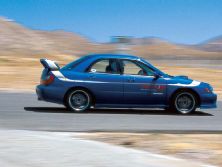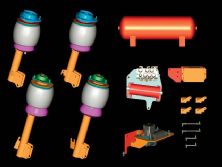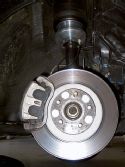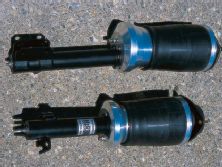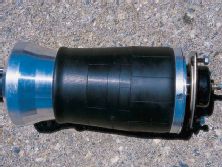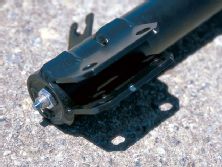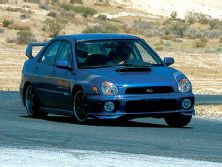Suspension upgrades are fraught with compromise. At odds are ride comfort and high performance. The key is finding a suspension system that delivers enough of each to get the job done, whether on the stuffy daily commute or during weekend warrior stints lapping the local road course. Oftentimes, though, you have to give up something. More often than not, you end up with either a cushy ride that squeals the tires during moderate cornering or a pogo-stick ride that handles well, but is painful on trips of more than 10 minutes.
The days of the no-compromise suspension are numbered. Praxis Advanced Suspensions, a division of Bridgestone, developed an air-spring suspension that can do it all, and do it all well. When the word "air" is used, people tend to assume "air bag"--an assumption that would be way off mark. An air bag usually fits within a coil or leaf spring setup and simply raises or lowers the vehicle. The Praxis air spring suspension offers effective spring rate changes, compression and rebound tuning, along with load leveling and corner weighting. Praxis worked with H&R Springs on the design and performance attributes of the system's aluminum-bodied inverted mono-tube dampers. The system offers three choices--Touring, Sport and Track.
Touring Mode
Touring mode provides ride and handling comparable to the factory-delivered vehicle. Original ride height, spring rate and damping produce a balance that's perfect for daily commutes or highway touring.
Sport Mode
Sport mode dramatically steps up handling responsiveness. Ride height is lowered 1 inch, while spring rate and damping are increased to reduce body motion and sharpen steering response. Attack that canyon road or enjoy an enthusiastic jaunt to work.
Track Mode
Track mode lowers the vehicle 2 inches, doubles spring rate, and provides the firmest damping of all. The system delivers a no-nonsense, no-compromise setup for the most aggressive amateur motorsport situations.
Road Course Testing
Praxis fitted a pair of WRXs with the suspension and invited select journalists to hammer on the Subarus on the Streets of Willow road course. Before track day, we drove the cars in Touring and Sport modes and compared them to a stock 2004 WRX on loan from Subaru. In Touring mode, it was difficult to detect any difference between Praxis and stock. In Sport mode, we noticed the reduction in ride height, and once under way, the car behaved like any dropped WRX. The ride was stiffer, there was much less body roll and steering response felt quicker. On the track, we evaluated the stock 2004 edition and Praxis-enhanced WRXs in Touring and Track mode. The Touring-mode car felt a touch stiffer on the track, but the track-mode car was clearly in a different dimension altogether. It was easy to tell just by monitoring steering input that the Track-mode car was significantly better. We found ourselves crossed up three or four times per lap in the stock car and not really at all in the track-mode car. The Subaru's tendency to plow was dramatically reduced and it was able to go into a turn hotter and not pay the price coming out of the corner. We were also surprised by how well the car rode, but it's wise to note that a well-groomed racing surface is not the same as a neglected city street.
Quick Q&A
Q: How does an air spring differ from a coil spring?
A: The visual difference is obvious. The operating principles are different. One produces a spring force by stressing a steel rod, while the other produces the same force by compressing a trapped volume of air. Functionally, there is no difference. The vehicle chassis only interacts with a spring force. It doesn't care whether that force originates from a steel spring or from an air spring. The airspring is different because we can control its properties. We can change its height (and the height of the vehicle) by controlling the pressure within the air spring. We can also change the spring rate in a dual-rate system by altering the volume of air contained inside the spring. To accomplish the same feat with a coil spring requires changing parts: more parts = more time = more money.
Q: How does the user change operating modes in the Praxis system?
A: Praxis allows the driver to select the height, spring rate and damping for whatever driving adventure lies ahead. There are no coil springs to change and no spanners to carry because the spring rate and ride height are controlled by air. It's as easy as touching a button and turning a knob. First, select one of three programmed ride height and spring rate levels with a simple push of a cockpit-mounted button. Then adjust damping by turning the adjuster conveniently located on each strut unit.
Q: Does raising and lowering the vehicle affect wheel alignment?
A: It's well known that toe and camber change as ride height is altered. Praxis' alignment specification (different than the factory specification) will allow daily use of touring and sport modes without affecting tire wear. When the car enters the track mode, the camber becomes more aggressive (that's bad). This is good for lap times and will not produce undesirable wear, considering the race-circuit environment. Randomly choosing an aggressive camber angle without regard for toe setting or other suspension characteristics usually results in rapid and irregular tire wear. You won't have to re-align the car when changing ride height. However, a one-time alignment will be needed when the system is installed.
The Future
Praxis will come out with two undisclosed additional applications in a matter of months, with more to follow as the company monitors the market. Considering the WRX's rallying history, the idea of enhancing handling while at stock ride height or higher was kicked around. This would be ideal for rally racing. Praxis has the capability to create such a configuration, but the demand for it needs to be higher. Also at issue was getting more than 2 inches of drop and controlling the rake front to rear. The problems with such procedures are ride characteristics; as the car is dropped, spring rates also change and a 3-inch drop would mean a really stiff spring. Tire Rack will be a prime mover for the system and the street price looks to be in the $3,400 range.

